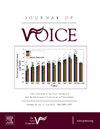Validation of the Polish Version of Voice Handicap Index-10
IF 2.4
4区 医学
Q1 AUDIOLOGY & SPEECH-LANGUAGE PATHOLOGY
引用次数: 0
Abstract
Purpose
The aim of this study was to adapt and evaluate the psychometric properties of the Polish version of the VHI-10.
Methods
We enrolled 183 subjects—118 patients with voice disorders and 65 without voice disorders.
Results
All items were correlated with each other and were strongly correlated with the total score (rho ≥ 0.70), the only exception being item five (rho = 0.56). Internal consistency was very high, with Cronbach's alpha = 0.92. There was a statistically significant difference between patients with voice disorders and healthy controls in terms of VHI-10 global score (U = 251.0; P < 0.001). There was a statistically significant negative correlation between mean phonation time (MPT) and VHI-10 (rho = −0.30; P < 0.01). Only the amplitude perturbation quotient (APQ) was correlated positively with the global score (rho = 0.22; P = 0.020). There were statistically significant and positive correlations between VHI-10 scores and GRBAS evaluation. Correlations between global scores of VHI-30 and VHI-10, and between VHI-30 subscales and the corresponding items from VHI-10, were very strong (respectively 0.97 and 0.89–0.94). In the patient group, there was high test–retest reproducibility (intraclass correlation = 0.91). A cut-off value of 8.5 points was estimated.
Conclusion
The Polish version of VHI-10 showed excellent internal consistency, good test–retest reproducibility, and had clinical validity. It is a useful brief tool for self-reported evaluation and reliable assessment of patients with voice disorders.
波兰语版语音障碍指数-10的验证
目的:本研究的目的是调整和评估波兰版VHI-10的心理测量特性。方法纳入183例受试者,其中有声音障碍患者118例,无声音障碍患者65例。结果除第5项(rho = 0.56)外,其余各项均与总分呈显著正相关(rho≥0.70)。内部一致性非常高,Cronbach’s alpha = 0.92。嗓音障碍患者与健康对照组的VHI-10整体评分差异有统计学意义(U = 251.0; P < 0.001)。平均发声时间(MPT)与VHI-10呈显著负相关(rho = - 0.30; P < 0.01)。只有振幅摄动商(APQ)与整体评分呈正相关(rho = 0.22; P = 0.020)。VHI-10评分与GRBAS评分之间有统计学意义的正相关。VHI-30和VHI-10的整体得分之间,以及VHI-30分量表与VHI-10相应条目之间的相关性非常强(分别为0.97和0.89-0.94)。在患者组中,重测重复性高(类内相关= 0.91)。估计临界值为8.5点。结论波兰版VHI-10具有良好的内部一致性和重复性,具有临床有效性。它是一个有用的简短工具,自我报告的评估和可靠的评估患者的声音障碍。
本文章由计算机程序翻译,如有差异,请以英文原文为准。
求助全文
约1分钟内获得全文
求助全文
来源期刊

Journal of Voice
医学-耳鼻喉科学
CiteScore
4.00
自引率
13.60%
发文量
395
审稿时长
59 days
期刊介绍:
The Journal of Voice is widely regarded as the world''s premiere journal for voice medicine and research. This peer-reviewed publication is listed in Index Medicus and is indexed by the Institute for Scientific Information. The journal contains articles written by experts throughout the world on all topics in voice sciences, voice medicine and surgery, and speech-language pathologists'' management of voice-related problems. The journal includes clinical articles, clinical research, and laboratory research. Members of the Foundation receive the journal as a benefit of membership.
 求助内容:
求助内容: 应助结果提醒方式:
应助结果提醒方式:


